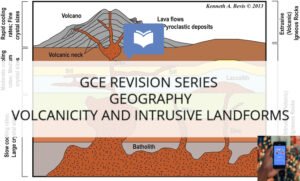volcanicity
LESSON 16: VOLCANOES AND MAN
VOLCANICITTY
It is the process were solid, gaseous and liquid materials are ejected on to the earth surface
A volcano is a mountain with an opening or hole called VENT which enables the out flow of materials from beneath onto the earth surface. Magma is stored in reservoirs called MAGMA CHAMBER
TYPES OF VOLCANOES
- Active volcanoes: These are volcanoes that show signs of recent eruption thus they are volcanoes that erupt. E.G Mt Cameroon
- Dormant Volcanoes: These are volcanoes that do not show any sign of recent eruption but could become active and erupt such volcano are set to be Merely sleeping E.G Mt Catmint in ALASKA
- Extinct volcanoes: These are volcano that has been erupting for a very long period say 2000yrs. They do not show sign of eruption and are believed to incapable of future eruptions E.G Mt Kenya
LESSON 17: FEATURES OF VOLCANICITY
Features of volcanicity are land forms resulting from the cooling and handling of magma within the earth crust and on the earth surface this features are classified into 2
- INSTRUSTIVE FEATURES.
These features are formed when magma cools and solidify with in the earth crust they include sill, dyke, laccolith, phacolith and batholith, lapolith
- A sill: is a horizontal sheet of igneous rocks that often extends for several kilometers. It thickness varies from 1 to 70meters. It is formed when magma penetrates horizontally along the bedding planes of sedimentary where it cools and solidifies. A sill can only be exposed when the overlying sedimentary rocks are removed by erosion E.G is the Great Whin Sill in North East England
- DYKE: A dyke is a narrow wall of igneous rock that cuts across the bedding planes of a sedimentary rock. It may be vertical or inclined. In size it is similar to the sill extending for several Km. It is formed when magma rises through vertical fissures cutting across the bedding planes of sedimentary rocks where it cools and solidifies. When the overlying rock is removed by erosion a resistant dyke may be form a wall like ridge E.G Cleveland Dyke of northeast Yorkshire
- Laccolith: A laccolith is a cake like mass of igneous rock that may sometimes attain the size of a mountain. It has a flat base and a dome shaped upper surface. It is formed where viscous magma fed side way from a bysmalith penetrates into a sedimentary rock forcing the overlying sedimentary layers to bulge at the surface the magma then cools and solidifies forming a laccolith E.G the Henry Mt in Utah, USA
- Batholith: It is a large, dome shaped mass of igneous rock, which sometimes forms the core or Root Mountains. Batholiths extend for up to tenths or even hundredths of kilometers. It is formed when large masses of rising magma cools and solidifies at great depth beneath the earth Due to the slow cooling of the magma large crystals develop in the igneous rock. When exposed by erosion, batholiths may form uplands or mountains. E.G Chaillu Massif in Gabon
- Phacolith: A phacolith is a lens shaped mass of igneous rocks that occupies the crest of an anticline and also, the base of a syncline in a folded sedimentary rock. It is formed when magma forced through a folded sedimentary rock cools and solidifies on the upper parts of the anticline and the lower parts of the syncline E.G Corndon Hills in Shropshire, ENGLAND
- Lopolith: A Lopolith is a large, saucer shaped mass of igneous rocks found along the bedding planes of a sedimentary rock. It is formed when magma forced through the bedding plane of sedimentary rocks cools and solidifies in the form of a shallow basin E.G Bushveld Lopolith in Transvaal, south Africa
- Extrusive Features
These are features formed when magma reaches the surface as lava, and then cools and solidifies. Extrusive volcanic features include Ash and Cinder cones, Lava cones, composite volcanic cones, and Caldera and lava plateau
- Ash and Cinder Cones:
These are symmetrical cones consisting of fragmentary materials. The height of ash and cinder cones is usually less than 300meters. It has steep, concaves sides with large craters on their summit. They result from violent volcanic eruptions during which lava is blown high into the air. The lava cools and solidifies into tiny fragments, which fall back to the surface around the vent accumulating to form ash and cinder cone. E.G Paricutin in Mexico
- Lava Cones:
These are cones formed when larva flow and build up volcanic. Two types exist
- Basics Lava Cones:
These are cones with gentle stops and broad base having a wide shallow craters and their sormith. They are formed when highly fluid lava is emitted on to the earth surface which spread over a long distance before cooling
- Acid Lava Cones
These are steep sided and narrow based lava cones. They are formed when highly vicious lava flowing only for a short distance cools and solidify. It is also called Cumulous Domes
- Composite Cones
The composite cone is also called the strato volcano. It is a large conical, shaped mountain buildup of alternative layers of ash and lava they are formed when several eruption occurs leading to the successive buildup of layers of ash and lava at times secondary cones are formed due to the escape of lava through sides of the cone forming Cone lets
- Caldera
These are large circular depression surrounded by high area of lock with steep side. They are formed when powerful eruption blows off the top of a mountain or when there is subsidence that is the top portion of the mountain collapses into the magma chamber E.G The Eboga and Elergum Calderas
LESSON19: IMPACTS OF VOLCANICITY
- Volcanic Hazards
- Loss of lives and people injured during volcanicity
- The destruction of crops and farms
- The damage of buildings, communication lines, electricity and pipe water
- Create some respiratory problems on men
- Make some people homeless
- Importance of volcanicity
- Volcanic eruption send out valuable minerals such as Nickel, Copper
- Volcanicity lead to the formation of interesting features or land forms which are attractive to tourist
- Volcanic rocks are quarried and use as building materials
- The sending out of rocks during volcanic eruption that are weathered to form fertile volcanic soils
- Adaptations and Mitigation
- Avoid living on steep slopes
- Avoid constructing story buildings
The use of seismograph to monitor the volcano in order to predict the type of eruption












